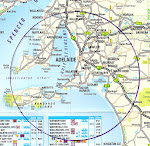Bush Tucker Field Trip
I jumped at the opportunity to tag along with a post "Wild flavours of Australia" conference field trip with the SANFA (South Australian Native Food Association) last Tuesday. We travelled to the Mount Pleasant area, to the property of Greg and Michelle Noel, who are growers of Muntries (Kunzea pomifera).
Landline - Muntries
Muntries (Kunzea pomifera).
Although they are naturally prostrate, they are grown in rows on trellis to facillitate harvesting
The trellis system also seems to increase production, and allows the fruit to be netted against birds.
They are irrigated in a similar fashion to grapes
Muntries (Kunzea pomifera).
The fruit is ripe in January, green or burgundy colour, tastes similar to apple.
This muntrie jam is actually 50% apple.
These straps are actually produced right here in Aldinga! with 15% Muntries 85% apple, no additives.
Hand cream has many other ingredients, with muntries added.
We then continued on to an old Gold and Copper mining site of Kitticoola, near Palmer where we visited a demonstration Native food site owned by John Del Fabbro.
This place was of particular interest to me as it has a rainfall of 350mm which is where we are heading here in Aldinga.
Santalum spicatum - Sandalwood
Sandalwood trees with their hosts
The Sandalwood was of particular interest to me as it was not being irrigated, (it is an arid land plant that grows on hard baked earth, gravel and sandy soil, rainfall 250-450mm) it produced a large nut which reminded me of a macadaemia in both flavour, texture, and oil content. I had never heard of Sandalwood being used as an edible crop.This is very exciting in terms of a multi use food crop, as the wood is used for incense and essential oils also. Sandlewood could be a very good survival crop as the nuts are very high in kilojules, fat and carbohydrates. Another thing I did not know, is that they need a host tree - they are a "hemi-parasite" they extract their water and nutrients from the host. The best hosts being Casuarinas, & Acacias.
Solanum centrale - Bush Tomato or Desert Raisin
The Bush tomato was a bit disappointing for me because it is used as a flavouring rather than a fruit, and it needs irrigation. I tried one and it had an intense bitter sweet flavour.
Used as a flavouring for soups stews and casseroles, and in Dukkah.
The Quandong like the Sandalwood needs a host tree, this one has killed it's host which is unusual.
Uses - used as stewed fruit, in pies, jams, and chutneys.
Wattle Seed - Acacia Victoriae
Uses - roasted and ground it makes a coffee substitute without the caffiene
the roasted seeds have the flavour extracted to make a syrup which can be used in place of vanilla essence.
Australian Native Bush Foods produce a Wattle seed extract which can be used to flavour beer, ice cream, and whipped cream. They also produce a Wattleseed Balsalmic vinegar.
The seeds that are left after the flavour is extracted are used to make facial exfoliants.
It is a spiney plant and is harvested similar to olives, by laying down sheets and knocking or shaking the trees with a pole.
Acacia victoriae - Wattle Seed
Native Lime Native limes
Native Fig
Native Fig - fruit does not get bigger than this
The trip has really helped to familiarise myself with these plants, and will certainly help me with my bush tucker orchard project here at the EcoVillage.






















No comments:
Post a Comment